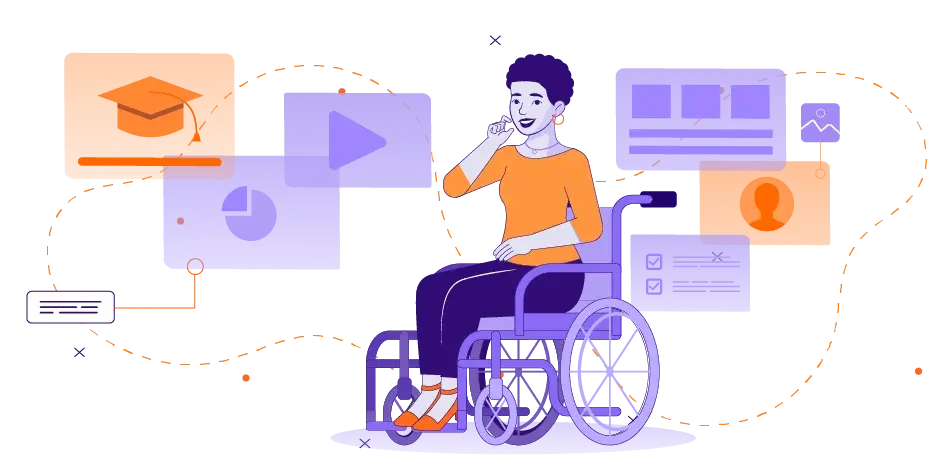
Microlearning Examples & Best Practices to Boost Employee Engagement
Microlearning is a powerful tool for boosting employee development and engagement. Think bite-sized lessons, easily digestible, and perfect for today’s busy workforce. It’s learning that fits right into the flow of work.
By delivering information in small, digestible chunks, microlearning makes it easier for employees to access, learn and retain new skills. This approach is particularly effective for today’s busy workforce, who often struggle to find time for traditional training.
This article provides practical microlearning examples and short video overviews. We’re also excited to announce the launch of the Microlearning Lab YouTube channel! This channel is your one-stop shop for everything microlearning. We’ll share expert insights, real-world case studies, and practical tips to help you transform your training.
To get inspired and learn more about microlearning and digital learning, check out the Microlearning Lab YouTube channel. Their channel offers a wealth of resources, insight from leading experts, and examples to help you create engaging and effective microlearning experiences.
What is microlearning?
Microlearning is a training approach that delivers information in small, focused bursts to maximize memory retention. It’s designed to cater to the preferences of modern learners who have short attention spans and prefer quick, digestible content. Microlearning can take many forms: short videos, quizzes, infographics, or even simple text messages.
Modern learners are used to consuming social medium information in bite sized chunks. They expect content to be visually appealing, interactive, and mobile-friendly. Microlearning meets these expectations by delivering content in a format that is easy to consume and digest.
Why consider microlearning?
The modern workplace is fast-paced. Employees need training that’s quick, relevant, and easy to access. Microlearning fits the bill perfectly. It’s designed for on-the-go learning, making it ideal for today’s mobile workforce.
Microlearning is a fantastic way to boost memory retention and skill development. By breaking down complex topics into smaller, easily digestible chunks, it makes learning more efficient and enjoyable. Imagine being able to learn new skills quickly and easily, fitting training into even the busiest schedules.
Microlearning is the perfect solution for organizations looking to enhance their training programs and improve employee performance. It is becoming a growing trend on google searches by learners and companies looking to deploy a microlearning strategy.
Benefits of microlearning
Increased Engagement:
Microlearning’s short form accessible nature, like videos, boosts learner motivation and active participation. This approach aligns with the way people naturally learn and process information, making training more enjoyable and engaging. A study by Software Advice found that 58% of employees would be more likely to use their company’s learning tools if the content was broken down into multiple, shorter lessons.
Improved Retention:
The bite sized format of microlearning aligns with how our brains naturally process information. Short bursts of focused content are easier to absorb and remember compared to lengthy training sessions. Research by Hermann Ebbinghaus, a pioneer in memory studies, suggests that people forget up to 90% of new information within a month, but spaced repetition, a key feature of microlearning, can significantly improve retention. Spaced Repetition – Ebbinghaus
Flexibility:
Microlearning’s flexibility empowers learners to access training on their own terms. Whether it’s during a commute, a lunch break, or before bed, learners can fit learning into their busy schedules. This accessibility accommodates different learning styles and preferences, leading to greater engagement and better outcomes. A survey by Deloitte found that 75% of employees prefer personalized learning experiences, and microlearning fits that bill perfectly. Deloitte – Personalized Learning

Microlearning Examples
Microlearning, with its short, focused bursts of information, has become a cornerstone of effective employee training. To illustrate the versatility of this approach, we’ve curated a series of microlearning examples across various industries. From healthcare to technology, finance to retail, you’ll discover how microlearning is revolutionizing training programs and driving performance improvement.
👉 Check out the Microlearning Lab YouTube channel. You can find a ton of great resources and Microlearning examples. 👈
Patient Education:
Learn how to quickly update your medication knowledge or master new treatment protocols with concise training modules.
Technology & Software:
Get up to speed on the latest software features or coding techniques through short, engaging lessons.
Finance:
Understand complex financial rules or explore new investment strategies with easy-to-digest training
Sales Enablement:
Enhance product knowledge or learn effective sales techniques through quick, interactive training.
Manufacturing:
Boost safety awareness or master new equipment operation with brief, informative modules.
Safety:
Quick interactive animation demonstrates safety training in a format that resonates with the learners.
Employee Onboarding:
A series of interactive videos introduces new hires to the company’s core values through relatable stories.
Leadership (Soft Skills):
A microlearning module offers tips and scenarios for giving constructive feedback in a positive way.
Customer Education:
A step-by-step visual guide helps older customers learn how to use a new online social media feature.
Cybersecurity:
An animated microlearning video on cyber fraud prevention with nontechnical users.
Compliance Training:
Understand new policies or improve public service delivery with concise, informative training.
Customer Service:
Learn how to handle customers or master customer interaction with an effective microlearning-based training course
Microlearning best practices
👉 Explore our Microlearning Lab Best Practices playlist for in-depth guidance on creating engaging and effective microlearning experiences. 👈
Keep it Short and Sweet:
Microlearning is all about brevity. Each module should focus on a single, clear learning objective. Avoid information overload; instead, deliver content in small, easily digestible chunks. Remember, the goal is to provide quick, impactful learning experiences.
Make it Mobile-Friendly:
Today’s workforce is constantly on the go. Ensure your microlearning content is accessible and optimized for mobile devices. This allows employees to learn anytime, anywhere, fitting training into their busy schedules.
Prioritize Engagement:
Dull content doesn’t cut it in the microlearning world. Use interactive elements like hotspots, simulations, and gamification to keep learners engaged. Incorporate visuals, such as images, videos, or infographics, to enhance understanding and retention.
Focus on Relevance:
Tailor your microlearning content to specific job roles and performance needs. By addressing real-world challenges, you increase the likelihood of knowledge transfer and application. Align your modules with overall business goals to maximize their impact.
Measure and Improve:
Track learner engagement and performance metrics to evaluate the effectiveness of your microlearning program. Use data to identify areas for improvement and make adjustments as needed. Continuously refine your content to ensure it meets the evolving needs of your employees.
Microlearning Strategy
A successful microlearning strategy is all about focus and impact. Pinpoint specific skills or knowledge gaps within your organization and deliver targeted, bite-sized learning experiences. Combine microlearning with traditional training for a powerful learning approach. Regularly measure how well your microlearning works and make improvements based on the data.

Microlearning Videos
Short, focused videos are a fantastic way to share information and engage your audience. Whether you’re training employees or educating customers, microlearning videos can make a big difference. Use them to explain complex topics simply, demonstrate processes, or reinforce key points. By making learning accessible and enjoyable, you can boost employee satisfaction and customer loyalty.
Here’s why microlearning videos are a top choice:
- Versatility: They can be used for a wide range of topics and audiences.
- Engagement: Visuals and audio keep learners interested and focused.
- Accessibility: Easily accessible on various devices for on-the-go learning.
- Retention: Visuals aid in memory and recall of information.
- Cost-Effective: Relatively inexpensive to produce and distribute.
Learning Experience Design
Microlearning offers a compelling solution to the challenges of modern workplace learning. By delivering concise, focused content, it effectively addresses the short attention spans and time constraints of today’s employees. This approach maximizes knowledge retention and skill development, ensuring that learning directly impacts job performance.
Good microlearning aligns with the principles of adult learning. It respects learners’ prior knowledge and experience, providing opportunities for skill enhancement and performance improvement. By offering flexibility and control over the learning process, microlearning boosts employee engagement and motivation. This leads to a more positive learning experience, fostering a culture of continuous improvement within the organization.
Enhanced Learning Outcomes and Engagement
Microlearning has demonstrated a significant impact on learning outcomes and employee engagement. A LinkedIn Learning Report found that short, focused learning segments can boost retention by 20% and increase employee engagement by 50%. This aligns with research from the Journal of Applied Psychology, which shows that breaking down complex topics improves comprehension and knowledge application.
Increased Efficiency and Cost Savings
Organizations are increasingly turning to microlearning to streamline their training processes. Bersin by Deloitte reports a 300% increase in development speed and up to 50% cost savings for companies using microlearning. The Association for Talent Development (ATD) supports this, stating that microlearning can reduce training time by 60% without sacrificing learning outcomes.
Positive Impact on Employee Performance and Satisfaction
Beyond learning efficiency, microlearning positively impacts employee performance and satisfaction. Brandon Hall Group research indicates a 50% boost in employee engagement and a 17% increase in job satisfaction when microlearning is implemented. SafetyCulture emphasizes the practical application of microlearning, highlighting its role in enhancing operational efficiency and reducing training costs.
Growing Adoption and Research
The effectiveness of microlearning has gained significant attention. A TechTrends bibliometric analysis reveals a surge in microlearning research, particularly post-COVID-19, as organizations sought efficient training solutions. Moreover, eLearning Industry reports a high adoption rate, with 98% of organizations planning to continue using microlearning due to its positive impact.
Shift Learning underscores the power of microlearning in boosting retention rates (up to 60%) and achieving high completion rates (82%), making it a compelling choice for organizations seeking to optimize their learning strategies.
Ultimately, microlearning is a strategic investment in human capital. By optimizing the learning experience, organizations can enhance employee performance, productivity, and satisfaction. This approach is essential for staying competitive in today’s rapidly evolving business landscape.

Challenges of microlearning
Developing good microlearning content can be challenging and creating concise, impactful learning modules requires careful planning and design. Balancing depth of information with brevity is a delicate task.
Measuring the impact of microlearning can be difficult. Traditional training methods often rely on pre and post-tests, but these might not be suitable for the short format of microlearning. Finding alternative methods to assess knowledge retention and skill improvement is essential.
Maintaining consistency in quality across multiple microlearning modules is another hurdle. Ensuring that all content adheres to the same design standards and learning objectives can be time-consuming. Managing the creation and distribution of numerous small modules can also be logistically challenging.
Integrating microlearning into existing learning management systems (LMS) can present technical difficulties. Adapting the LMS to accommodate short-form content and tracking learner progress effectively might require additional development or customization.

Cost-effectiveness is a crucial consideration. While microlearning can be efficient, producing high-quality content requires resources. Balancing the need for engaging, interactive modules with budgetary constraints can be challenging.
Developing effective microlearning content is no small feat. Creating concise, impactful learning modules requires careful planning and design. Balancing depth of information with brevity can be tricky. Ensuring consistency across multiple modules is another hurdle. Integrating microlearning into existing learning management systems can also pose challenges. And finally, measuring the impact of microlearning can be complex.
Overcoming these challenges requires careful planning and the right tools. By investing in a robust authoring tool and leveraging data analytics, organizations can create engaging and effective microlearning experiences.
Are you ready to explore the potential of microlearning? Contact us to learn how we can help you overcome these challenges.
DOWNLOAD YOUR KEY TO KNOWLEDGE
Access Valuable Resources to Fuel Your Learning Journey


